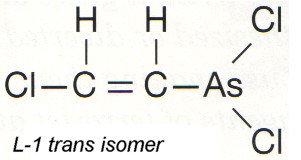British anti-Lewisite
By Domingo Tabangcura, Jr. and G. Patrick Daubert, MD
Development
The development of BAL must first start with its nemesis: Lewisite. Lewisite is
a combination of acetylene and arsenic trichloride (figure 1) and has also been
known as the “Dew of Death.” Lewisite gets its origin from acetylene. In
the 1800s the world was failing to come up with a synthetic rubber. A young man
named Julius Arthur Nieuwland (figure 2) was a graduate student at the Catholic
University of America in Washington D.C. He was conducting research on
acetylene hoping for a solution to synthetic rubber (Father Nieuwland did later
discover how to make synthetic rubber from acetylene in 1923). Father Nieuwland
subsequently became interested in acetylene gas. His doctorate thesis in 1904
entitled "Some Reactions of Acetylene" outlined the synthesis of a poisonous
gas from acetylene and arsenic trichloride (aka Lewisite).[1] However, being an
honest Catholic, he feels that is best not to introduce the world to a
poisonous gas. This is not true of its rediscovery. In 1918 CPT W. Lee Lewis
begins his search for chemical warfare agents. He was stationed at the Catholic
University of America were he uncovered the thesis by Father Nieuwland.[1]
Captain Lewis perfects the synthesis of Lewisite referring to it as "the stuff
beside which mustard gas becomes a sissy's scent!"[1]

Figure 1: Lewisite
|
|

Figure 2: Father Julius Arthur Nieuwland
|
The rediscovery of Lewisite in 1918 was too late for its use as a chemical warfare agent in WWI.
However, the allied forces were well-aware of its existence at the start of
WWII. At an Oxford laboratory under the keen supervision of Sir Rudolph Peters
the search was on for antidotes to various chemical agents. On July 21, 1940,
the Oxford lab first synthesized BAL.[2] For security reasons It was initially
termed OX 217 and not declared to the public until 1945.[3]
BAL was involved early on in the treatment of other conditions because of it known chelation
profile. In the late 1940s it was used in the management and diagnosis of
Wilson's disease.[7] Wilson's disease is a severely debilitating disease that
causes increased copper deposition with resultant liver and brain injury[4]
There was a dramatic improvement seen in patients with Wilson’s disease treated
with BAL.[5-7] BAL was critical to the understanding and treatment of this rare
disease and to the field of neurology.[8]



